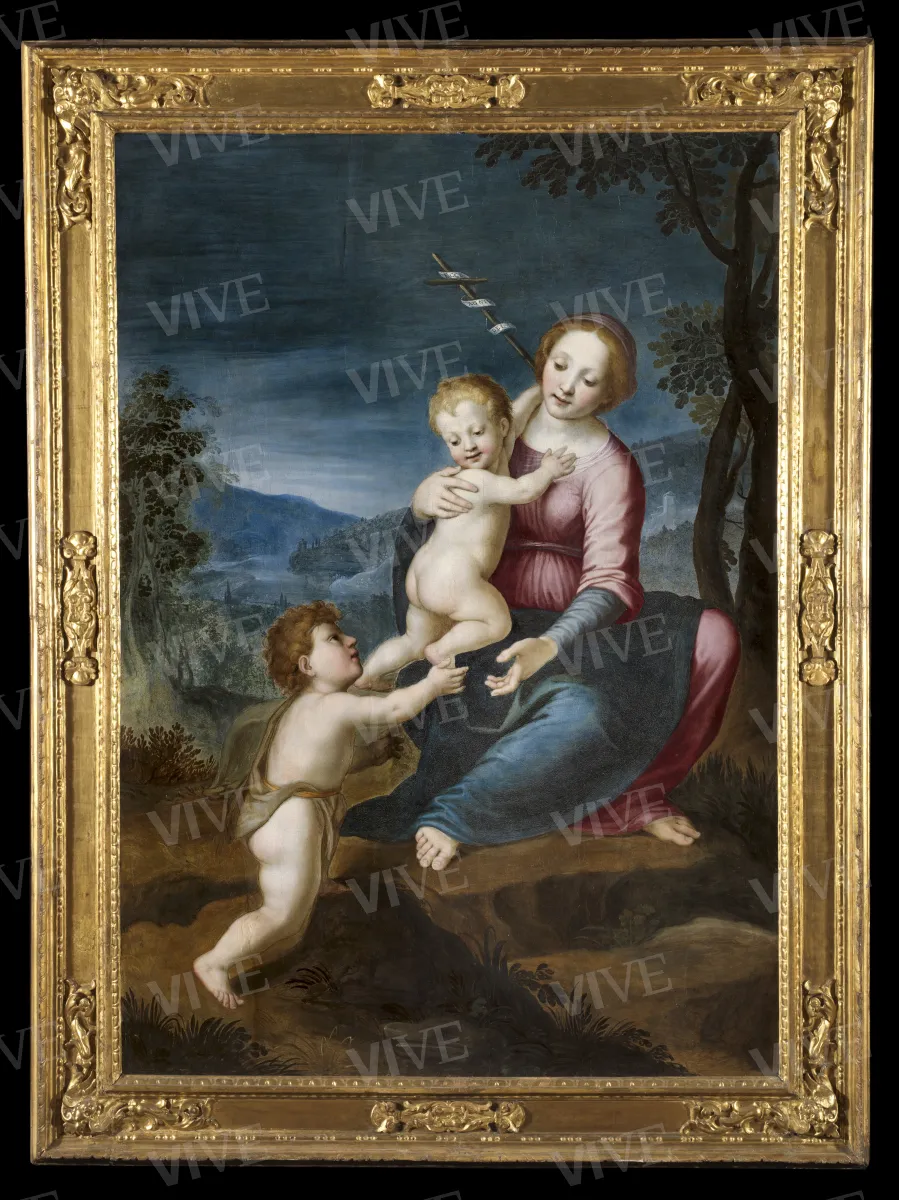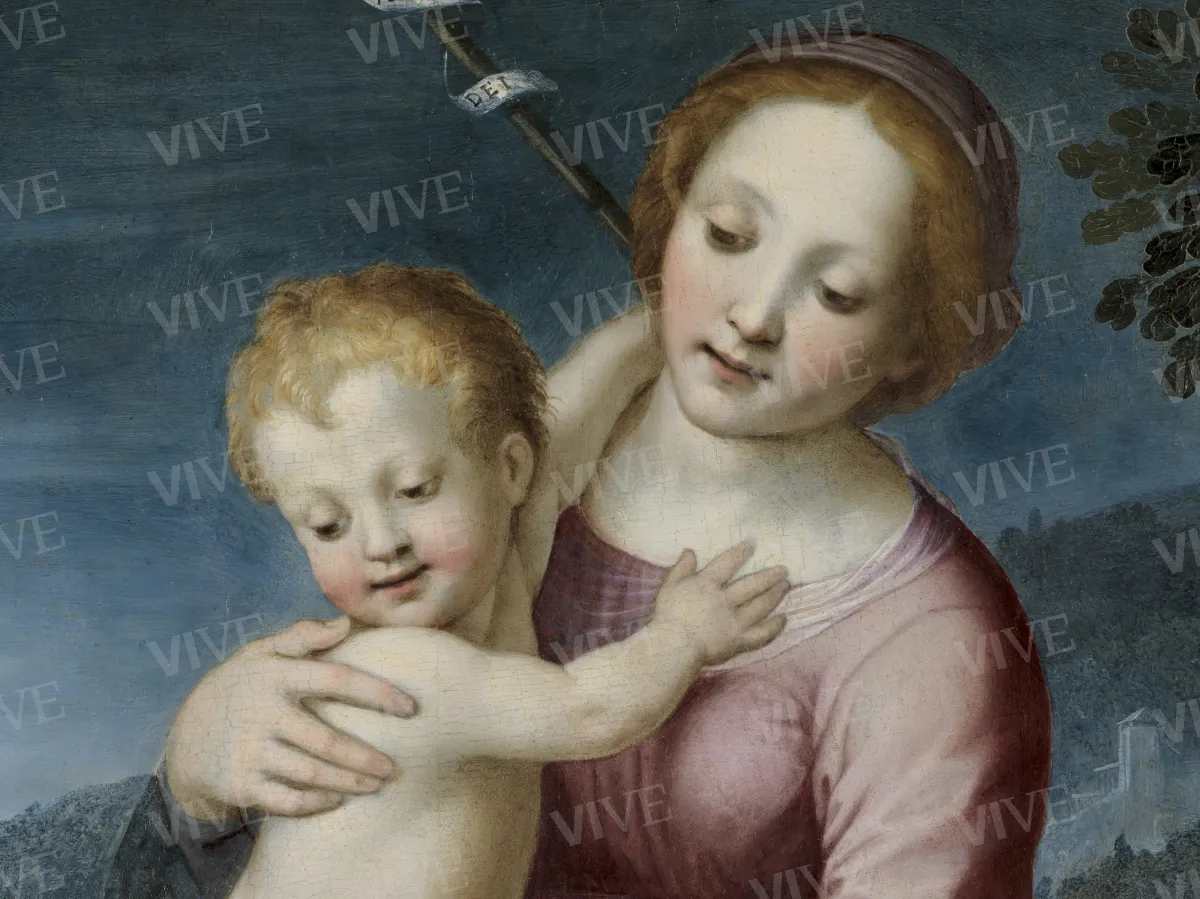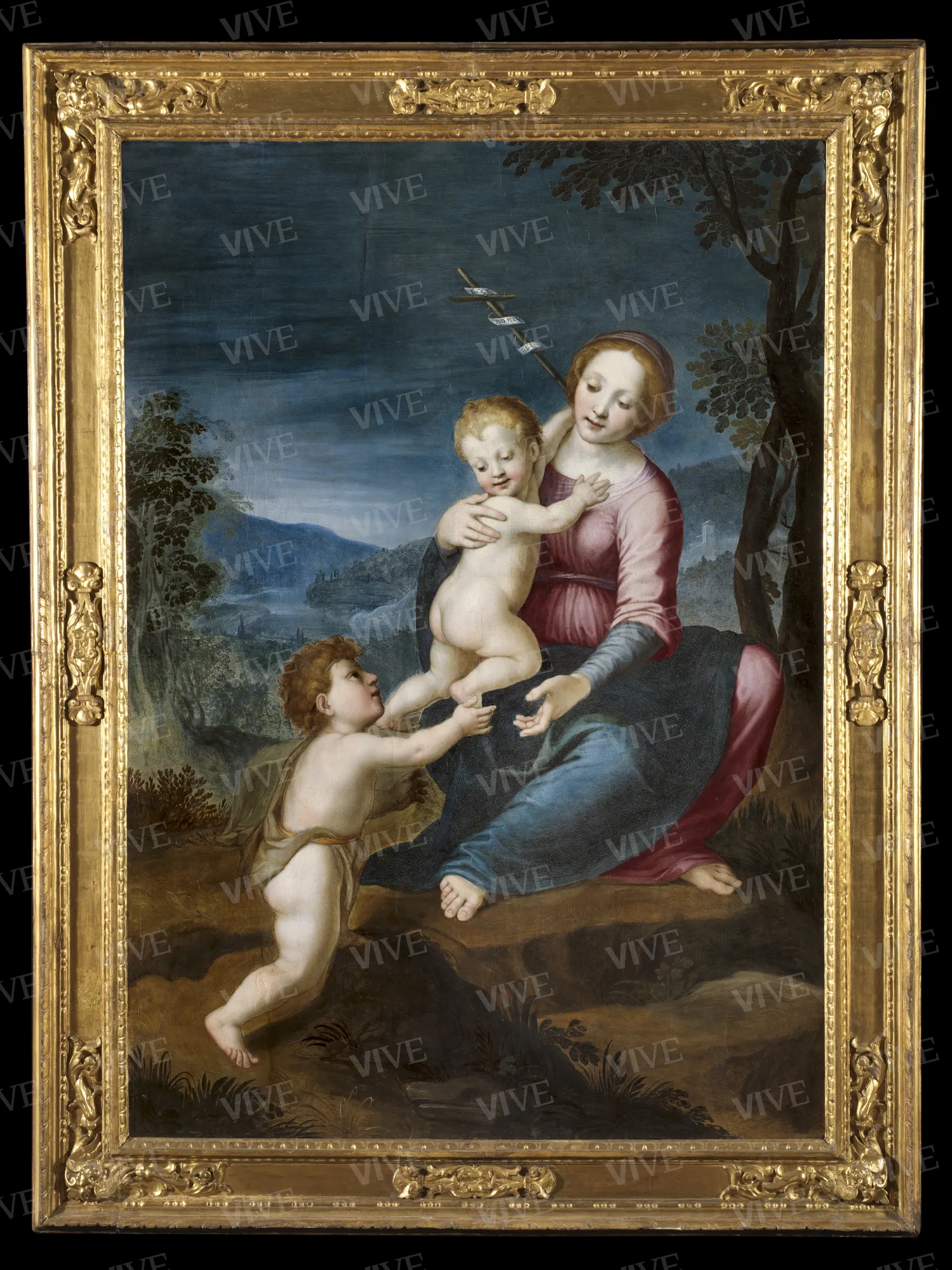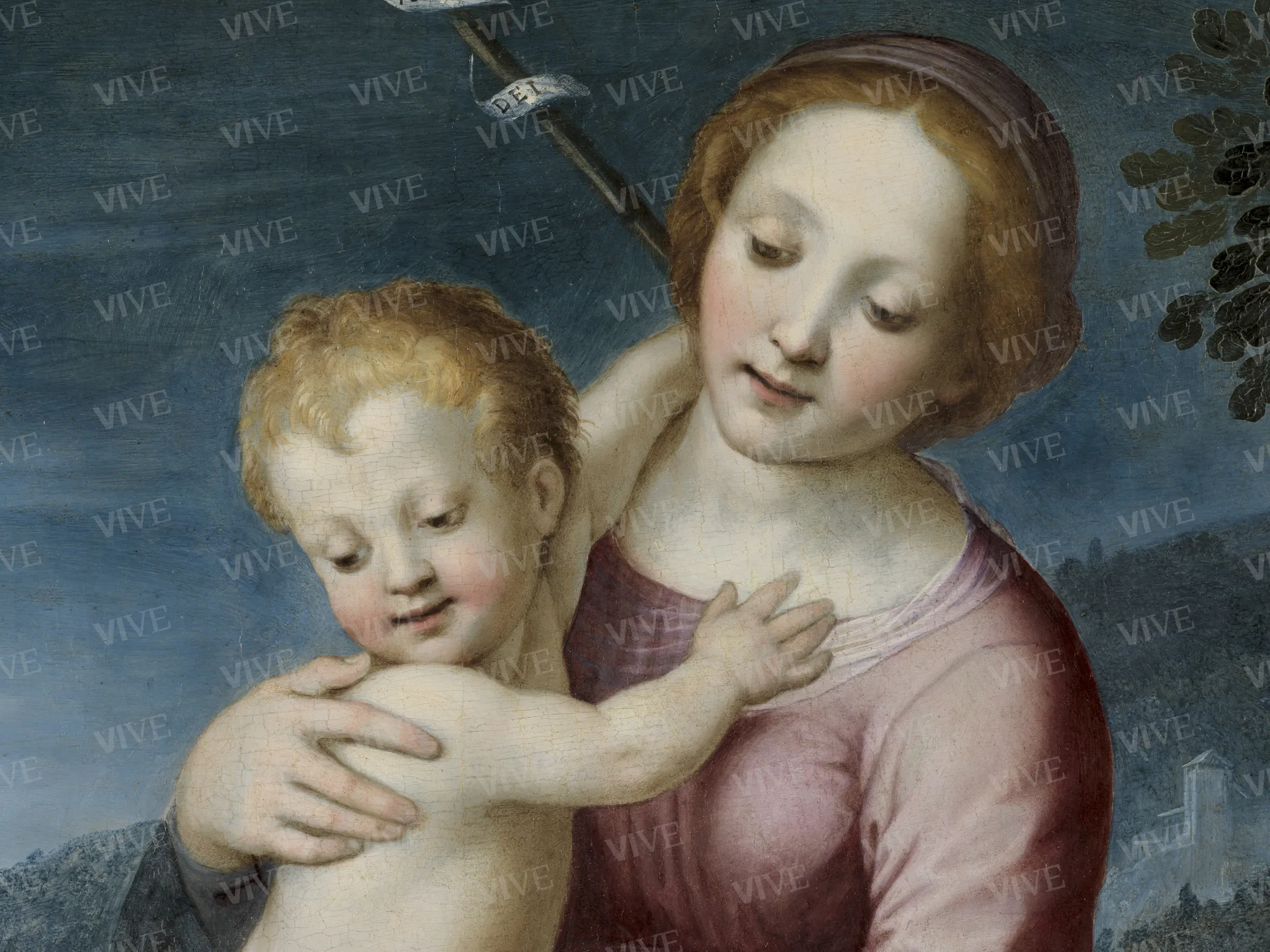Madonna with Child and Saint John the Baptist
From Jacopo Torni called L'Indaco? 1570–1599
The Madonna with Child and Saint John the Baptist is a variation of the Madonna del Pozzo (Madonna of the Well) at the Uffizi Galleries in Florence, which has been attributed to Jacopo Torni, also known as Indaco. The Florentine prototype is named after the background scene featuring a well, inspired by a 1504 engraving by Dürer, which does not appear in the painting at Palazzo Venezia. The primary difference between the two works lies in the landscape; this painting features an almost nocturnal setting and is likely dated to the end of the century.
The Madonna with Child and Saint John the Baptist is a variation of the Madonna del Pozzo (Madonna of the Well) at the Uffizi Galleries in Florence, which has been attributed to Jacopo Torni, also known as Indaco. The Florentine prototype is named after the background scene featuring a well, inspired by a 1504 engraving by Dürer, which does not appear in the painting at Palazzo Venezia. The primary difference between the two works lies in the landscape; this painting features an almost nocturnal setting and is likely dated to the end of the century.
Details of work
Catalog entry
The Madonna with Child and Saint John the Baptist is based, with some differences, on the painting known as the Madonna del Pozzo, which is housed in the Uffizi Galleries in Florence and attributed to Jacopo dell’Indaco. The work was part of Cardinal Tommaso Ruffo di Bagnara’s collection, although the date it became part of the collection is unknown. It is not listed among those exhibited by the prelate between 1702 and 1705 in the exhibitions curated by Giuseppe Ghezzi in San Salvatore in Lauro in Rome, which did not include his entire picture gallery (De Marchi 1987, 167–168, 187, 195, 197; De Angelis 2010, 57). Believed to be by Raphael, it has been documented in the cardinal’s possession since at least 1734, as indicated by Jacopo Agnelli’s description. He saw the work in the archbishop’s palace in Ferrara, where Tommaso Ruffo resided when he was bishop of the city from 1717 to 1738 (Agnelli 1734, 62-63; Ferrara 2008; De Angelis 2010, 54; Ferrara 2011; Caridi 2017, 89, 158–160; Haskell 2019, 293). Upon moving to Rome, Tommaso Ruffo relocated the collection to his residence in the Palazzo della Cancelleria (De Angelis 2010; Gioffré 2014; De Angelis 2013). The painting is mentioned in the inventory compiled after Cardinal’s death in 1753 by Sebastiano Conca and Giovanni Sorbi. In his will from December 1752, he designated his nephew Litterio as his sole heir and arranged for the picture gallery to be transferred to Naples (De Angelis 2010, 55–56, 68, 76–77, n. 78; Salvatore 2013, 116; Paviolo 2014). The panel was displayed, still attributed to Raphael, at the Neapolitan exhibition on April 8, 1877 (Esposizione dell’arte antica napoletana 1877, 155; Battista 2005, 65–66, 73, n. 14) and is recorded in Naples in the inventory of Fabrizio Ruffo’s possessions dated June 22, 1909. In that document, the proximity of the painting to the so-called Madonna del Pozzo degli Uffizi, then believed to be by Raphael, was noted; this comparison led to the Florentine work being considered an “improved reproduction by the same author” and therefore excluded “the possibility” that both paintings could be attributed to Raphael (Battista 2005, 75, n. 12). The panel was subsequently downgraded to “pupil of Raphael, possibly Giuliano Bugiardini” in the deed of donation of the Ruffo di Bagnara collection to the Italian State on May 15, 1915 (Battista 2005, 78, n. 16). After entering the Museum of Palazzo Venezia, Antonino Santangelo considered the painting the work of a Florentine painter and Roberto Longhi dated it around 1520-1530, a judgment confirmed by Federico Zeri (Santangelo 1947, 19; Zeri 1955, 10, n. 165).
The authorship of its prototype, the Madonna del Pozzo, which is variously dated to the 1510s, is disputed. The Uffizi panel is believed to originate from the destroyed church of San Pier Maggiore, based on Giorgio Vasari’s description that mentions a Madonna with Child and Saint John the Baptist by Franciabigio in that location; this work was also mentioned by Francesco Bocchi as being by Andrea del Sarto (Vasari [1568] 1976, IV, 506; Bocchi, in Bocchi Cinelli [1591] 1677, 358). According to Giovanni Cinelli, the painting was acquired by Cardinal Carlo de’ Medici, and in his inventory of 1667, the Madonna del Pozzo is listed as being by Franciabigio (Cinelli, in Bocchi Cinelli 1677, 358; McKillop 1974, 155, n. 26). It was exhibited in the Tribuna degli Uffizi under the name of Raphael until Joseph A. Crowe and Giovan Battista Cavalcaselle identified it as the work mentioned by Vasari and attributed it to Franciabigio, an attribution largely accepted by critics, with some exceptions suggesting Giuliano Bugiardini (Crowe, Cavalcaselle 1866, III, 501; McKillop 1974, 155–157, n. 26). Based on doubts expressed by Longhi, Fiorella Sricchia Santoro has recently suggested that the artist may be Jacopo Torni, known as l’Indaco (Longhi 1953, 43, 54; Sricchia Santoro 1963; Sricchia Santoro 1993; Zurla 2010-2011; Padovani 2012, 26).
The widespread popularity of the Florentine painting is evidenced by numerous copies, as reported by Susan Regan McKillop. Some copies are known only from photographs. Additionally, there exists a cartoon at the Fitzwilliam Museum in Cambridge, which was likely not preparatory for the final work. Due to its extremely poor state of preservation, it is impossible to identify the author or function of this cartoon (De Amicis 1898; McKillop 1974, pp. 157, 187, 197, 208, 212, 216, 220; Scrase 2011, pp. 261-262, n. 232). The painting in Palazzo Venezia exhibits notable differences from the Madonna del Pozzo. It is larger with different height and width proportions compared to the Uffizi painting, which measures 106 x 81 cm. The characters are similar to those in the original, except that Saint John holds the cross and scroll in the former, while in this panel, the Child holds the cross wrapped in a scroll with the inscription “ECCE AGNUS DEI.” A key difference lies in the landscape depiction; the section featuring the well on the left side of the background, which named the work and was inspired by a 1504 engraving by Dürer, is absent (Sricchia Santoro 1993, 13; Scherbaum 2001, I, 114–115).
The author’s approach to the model indicates that this copy was made at a later date, aiming to modernize certain elements of the composition that were considered outdated. This is especially noticeable in the landscape: the detailed depiction of the inhabited countryside, with its clear, early morning air in shades of blue and green, is altered to resemble a nocturne. It is structured in a series of distant valleys and mountains in various shades of blue, contrasting with the brown, almost black, colors of the ground and the two trees on either side serving as a backdrop. The Virgin’s dress also reflects this chromatic change, shifting from red to pink. The impressive landscape of the Palazzo Venezia painting is not typical of early sixteenth-century artwork, indicating that the piece was likely created at the end of the century.
Francesca Mari
Entry published on 12 June 2025
State of conservation
Fair. The depiction of Saint John appears less complete than the rest of the group, with visible brushstrokes around the body and noticeable pentimenti. However, a comparison with a historical photograph from the Central Institute for Cataloguing and Documentation (GFN 35143) indicates that this appearance may be entirely or partially due to excessive cleaning, which has resulted in the loss of portions of the paint finish, such as the saint’s fur. Similar effects are also observable in other areas of the landscape and on the tree tops.
Restorations and analyses
On the reverse, the support has been restored with wooden inserts at the joints of the panels..
Provenance
Ferrara, Cardinal Tommaso Ruffo di Bagnara collection, by 1734 and until 1738;
Rome, Cardinal Tommaso Ruffo di Bagnara collection, until 1753;
Naples, Litterio Ruffo collection, from 1753;
Rome, Museo di Palazzo Venezia, donated by Fabrizio Ruffo, May 15, 1915.
Exhibition history
Naples, Esposizione dell’arte antica napoletana, 1877.
Sources and documents
Photograph from the Kunsthistorisches Institut in Florence (Franciabigio folder);
ICCD photograph (inv. E 35143).
References
Bocchi Francesco, Cinelli Giovanni, Le bellezze della città di Firenze, dove a pieno di pittura, di scultura, di Sacri Templi, di Palazzi i più notabili artifizi, e più preziosi si contengono. Scritte già da M. Francesco Bocchi ed ora da M. Giovanni Cinelli ampliate e accresciute, Firenze 1677;
Agnelli Jacopo, Galleria di pitture dell’E.mo, e R.mo Signor Cardinale Tommaso Ruffo, Vescovo di Palestrina, e di Ferrara, ecc., Ferrara 1734, pp. 62-63;
Crowe Joseph Archer, Cavalcaselle Giovanni Battista, A New History of Painting in Italy from the Second to the Sixteenth Century, III, London 1866;
Esposizione dell’arte antica napoletana. Catalogo generale dell’arte antica, catalogo della mostra (Napoli, 8 aprile 1877), compilato dal Comitato Esecutore, Napoli 1877, p. 155;
De Amicis Franco, Raffaello Sanzio e la scoperta di un suo quadro, Amsterdam 1898;
Santangelo Antonino (a cura di), Museo di Palazzo Venezia. Catalogo. 1. Dipinti, Roma 1947, p. 19;
Longhi Roberto, Avvio a Pier Francesco Toschi, in «Paragone», 43, 1953, pp. 53-55;
Zeri Federico (a cura di), Catalogo del Gabinetto Fotografico Nazionale. 3. I dipinti del Museo di Palazzo Venezia in Roma, Roma 1955, p. 10;
Sricchia Santoro Fiorella, Per il Franciabigio, in «Paragone», 163, 1963, pp. 3-64;
McKillop Susan Regan, Franciabigio, Berkeley 1974, pp. 157, 212;
Vasari Giorgio, Le vite de’ più eccellenti pittori scultori e architettori nelle redazioni del 1550 e 1568, Barocchi Paola, Bettarini Rosanna (a cura di), IV, Firenze 1976;
De Marchi Giulia, Mostre di quadri a S. Salvatore in Lauro (1682-1725). Stime di collezioni romane. Note e appunti di Giuseppe Ghezzi, Roma 1987;
Sricchia Santoro Fiorella, Del Franciabigio, dell’Indaco e di una vecchia questione. II, in «Prospettiva», 71 1993, pp. 12-33;
Scherbaum, in Schoch Rainer, Mende Matthias, Scherbaum Anna (a cura di), Albrecht Dürer. Das druckgraphische Werk. Kupferstiche, Eisenradierungen und Kaltnadelblätter, Münich, London, New York 2001, I, pp. 114-115, n. 40;
Battista Stefania, La collezione Ruffo di Bagnara: alcuni documenti inediti, in Pavone Mario, Giannone Antonio L. (a cura di), Percorsi d’arte, tra vestigia dei Messapi il collezionismo dei Ruffo e l’evoluzione pittorica di Mino Delle Site, catalogo della mostra (Cavallino, Lecce, Convento di San Domenico, 30 gennaio-13 marzo 2005; Salerno, Pinacoteca provinciale, 23 marzo-1 maggio 2005), Salerno 2005, pp. 65-68; p. 73, nota 14; p. 75, n. 12; p. 78, n. 16;
Ferrara Tiziana, La Galleria ferrarese del Cardinale Tommaso Ruffo secondo la descrizione dell’Agnelli, in Abbate Francesca (a cura di), Percorsi di conoscenza e tutela, Pozzuoli 2008, pp. 425-431;
De Angelis Maria Antonietta, I dipinti del cardinale Tommaso Ruffo (1663-1753): la quadreria di un alto prelato nella Roma del Settecento, in Debenedetti Elisa (a cura di), Collezionisti, disegnatori e pittori dall’Arcadia al Purismo, Roma 2010, pp. 53-92, nota 78;
Zurla Michela, Jacopo Torni detto l’Indaco, in «Proporzioni», XI-XII, 2010-2011, pp. 39-68;
Ferrara Tiziana, Proposte in merito all’individuazione di alcuni dipinti della collezione ferrarese del cardinale Ruffo, in Lorizzo Loredana (a cura di), Fare e disfare, Roma 2011, pp. 65-73;
Scrase David, Italian Drawings at the Fitzwilliam Museum, Cambridge. Together with Spanish Drawings, Cambridge 2011;
Padovani Serena, Intorno a Piero di Cosimo. Il filo rosso di alcune attribuzioni sbagliate, in «Commentari d’arte», 51, 2012, pp. 18-32;
De Angelis Maria Antonietta, L’ultimo soggiorno a Roma del cardinale Tommaso Ruffo (1738-1753), in Pavone Mario Alberto (a cura di), Il collezionismo del cardinale Tommaso Ruffo tra Ferrara e Roma, Roma 2013, pp. 171-212;
Salvatore Donato, Il ritratto di Jacopo Sannazaro attribuito a Raffaello, in Pavone Mario Alberto (a cura di), Il collezionismo del cardinale Tommaso Ruffo tra Ferrara e Roma, Roma 2013, pp. 115-119;
Gioffrè Domenico, Potenza e mecenatismo dei Cardinali della Gran Casa dei Ruffo di Bagnara, in «Calabria sconosciuta», 143/144, 2014, pp. 53-57;
Paviolo Maria Gemma, I testamenti dei cardinali. Tommaso Ruffo (1663-1753), Morrisville 2014;
Caridi Giuseppe, Ruffo Tommaso, ad vocem, in Dizionario Biografico degli Italiani, 89, Roma 2017, pp. 158-160;
Haskell Francis, Mecenati e pittori. L’arte e la società italiane nell’età barocca, Montanari Tomaso (a cura di), Torino 2019.














